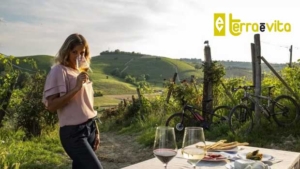
Over two hundred festivals, fairs, tasting festivals, and sporting events involving just under six hundred certified agri-food products and 144 protection consortia. These are some of the most significant statistics on tourism related to Italian DOP wines and obi, included in the first report on DOP Tourism produced by the Qualivita Foundation in collaboration with Origin Italia and with the support of the Ministry of Agriculture , recently presented in Rome.
The food and wine travel industry has a significant impact on the rural economy and helps support the incomes of many farms, especially smaller ones.
The analysis , based on direct surveys and the examination of institutional sources, highlights a total of 585 activities serving the new tourism model, promoted by 361 protection consortia involving 597 PDO and PGI products . In 2024, 235 events were registered , 132 of which were dedicated to food and 108 to wine. In addition, 188 permanent infrastructures and 130 enhancement elements, official recognition of the areas of origin of PDO and PGI products, and 32 specific information initiatives were carried out. The presence of 103 roads and itineraries, 17 UNESCO sites, 29 historic rural landscapes, and 82 parks and protected areas were also noted.
It's difficult to precisely quantify the turnover generated by PDO tourism and its direct impact on the primary sector, but some numbers are nonetheless significant. According to Eurostat, in 2024 , Italy was the second-most popular tourist destination among EU countries for global travelers, with over 458 million overnight stays (+2.5% compared to 2023), behind only Spain with 500 million. Furthermore, the European statistical institute states that food and wine experiences are the second-most popular tourist activity among tourists, after cultural activities .
According to 2024 data and trends from ENIT (National Tourism Agency), tourism contributes 10.8% of Italy's GDP. It generates approximately 13% of employment and, according to forecasts, could reach 12.6% of GDP over the next ten years. In 2024, foreign tourists spent €54 billion in Italy. Meanwhile, the overall value of food and wine tourism is €40 billion, with a 176% increase in foreign visitors for food and wine over the past ten years and a 70% increase in Italians taking a food and wine vacation in the past three years.
"Food and wine itineraries in rural areas can generate increased employment by revitalizing villages that would otherwise face depopulation," writes Luigi Mundula , professor of geography at the University for Foreigners of Perugia, in the report. He adds: "In the case of Tuscany, the GI system has triggered inclusive development processes, involving small producers in collaborative networks."
[…]
Like all human activities, PDO tourism must also address sustainability , encompassing three dimensions: environmental, economic, and social. The 226-page report also addresses these issues. "To be sustainable, tourism must fully consider its current and future economic, social, and environmental impacts, responding to the needs of travelers, the industry, the environment, and the host communities," writes CSQA director Maria Chiara Ferrarese .
Specifically, in the context of Geographical Indications, this means "offering tourist experiences that respect agricultural production cycles, promote responsible consumption of certified local products, and enhance cultural and gastronomic traditions without altering environmental balances. It's therefore not just about attracting visitors, but about further increasing the positive impact of geographical indications on the local area and the community by generating added value for local communities, fostering a circular economy, limiting overtourism, and preventing the trivialization of offerings." Easy to say...
[…]
Source: TerraèVita